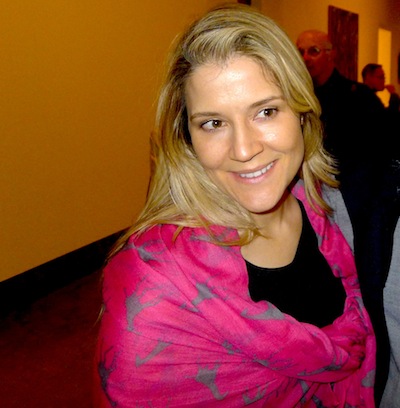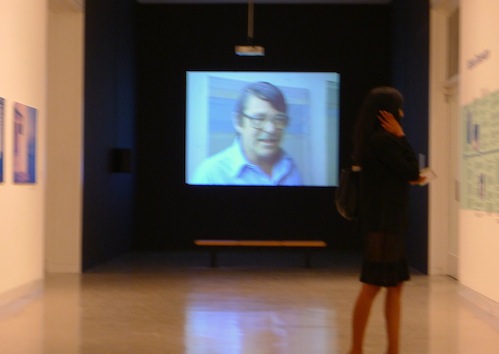Every once in a while there is an art exhibit that is so perfect it serves as a litmus of each viewer who takes it in. Years later you can bring up such a show and gage many things about a person based on their response. Someone who loved it is able to start a sentence about the experience and a complete stranger who was also just as moved can walk up and finish the expression of resonant passion. People who go against the grain and shrug off these perfect shows build islands of distance that often become whole schools of thought and art movements based almost solely on the hope of storming that mainland of affirmation and finally winning the argument.
This type of divide in the presence of great art and sensitive curating is not exclusively between those who dislike an epic show and those who love it. Those who do not attend can be anthropologically understood as outcasts. You can miss a great show because you were not born yet. Otherwise, if you are an art initiate, you hear the buzz and you know there are some shows that just demand mandatory attendance. While most exhibits can be avoided with time honored excuses of "I'm so busy" or "It was too far to drive," the occasional epic demands that those who care about art make the time to see it; those just posing as they toggle together a career skip out on these at the risk of expulsion from the tribe.
A viewer ponders "Ocean Park #96, 1976" at the press preview for "Richard Diebenkorn: The Ocean Park Series" at the Orange County Museum of Art.
The survey of painter Ricard Diebenkorn's Ocean Park paintings currently on view at the Orange County Museum of Art is one of these epic shows. If you miss this one, you are just not into art. Maybe you're buzzing around some tertiary sphere like design or product photography or academic advancement, but you are not really with those of us who like art.
This exhibit is a litmus test both of whether you make time for great art and how sensitive you are to paintings that are as good as it gets. How do you feel about being in the presence of art that hangs with the most rigorously challenging abstraction and yet is as unabashedly sentimental as holding hands on the beach at sunset? Richard Diebenkorn created mesmerizing paradoxes with these pictures that tossed away all references to representation and yet confirmed a sense of place and geography far more informed than any illustrative landscape could hope for. Deceptively simple, the placidity of these paintings is an antidote to the conceptual, but not to the intellect; in the Ocean Park series intelligence is paired with relapsing emotion.
�The story of the Ocean Park series is simple enough, and it bears retelling if only to today's art world made up of dealers looking for kids under 25 to lead them to the next big thing. At 45 years old, painter Richard Diebenkorn left the Bay Area for Southern California and got a cheap-rent studio in the then semi-slum district of Ocean Park, a beach-hugging sliver of houses and surf shacks between Santa Monica and Venice. An established painter of figures and landscapes who had dabbled in abstraction in his youth, Diebenkorn almost immediately returned to abstract painting in the light and space of Southern California.
Curator Sarah Bancroft
Curator Sarah Bancroft brilliantly begins the chronological exhibition with Diebenkorn's first picture from the space: a small landscape painting of the view out his studio window. The topography of palm trees and the sharp architecture of simple civilization depicted here then dissolve into an echo of the spatial light of the region. The artist reiterated that dissolve over two decades in hundreds of paintings and prints, more than 80 of which are gathered at OCMA. The show opened in Fort Worth but Bancroft confided to me, "They look so good here because they've come home." Again sentimentality collides with certainty when the subject is Diebenkorn, and what might have been an unresolved collision between two diametric approaches at the hand of another artist is but a sweet blend in the work of this master.
The artist dove into this abstract sea in 1967, just when many longstanding abstract painters were turning back. Al Held famously remarked that this was the year he decided to violate Clem Greenberg's picture plane. Soon after, Phillip Guston woke up to see raw cartoon figures on his studio canvasses instead of undulating color fields. Seeing no way out by 1970, Mark Rothko slit his wrists. Instead of making any type of radical break, though, Diebenkorn married the unbearable rightness of abstraction with the immeasurable lightness of landscape. Yet, like all great art out of the 1960s, if you were doing your own thing it was impossible not to be of your time.
There are a few things that make the major Ocean Park paintings special. The scale of each abstracted landscape is wider than your arms stretching out and taller than anyone in the room (at least until Shaq decides to take in this show). This scale means you are free to see the picture from an angle. In fact, from off to the side, the occasional diagonals pull you into the misty marine layer light as effortlessly as if you are standing front and center with your feet in the sand. The smaller works though, and there are many brilliant ones included in this show, seem to give the viewer an easier grasp on the landscape where familiar geometry contains natural color. But the large canvasses are ultimately the draw regardless of the secrets to their success one can discover in the cigar box lid masterpieces.
Archive videos of Richard Diebenkorn discussing his artwork accompany a rich timeline biography as pictured here at the press preview of "Richard Diebenkorn: The Ocean Park Series" at the Orange County Museum of Art.
While many big art players (from the Met in New York, to the Sheldon in Nebraska to Eli Broad just up the coast) can afford one Ocean Park series picture, few if any have more than two. Just like the economics that turned Diebenkorn's storefront studio a block from the beach on Main Street and Ashland Avenue into a parking lot across from a condo tower on the beach, each Ocean Park painting has become an expensive piece of real estate. Viewers anywhere in the country can always see one somewhere, but seeing so many of them together is the reward here, and it is a curatorial gift rarer than affordable studio space near the beach. Richard Diebenkorn: The Ocean Park Series runs thru May 27 at OCMA and then travels to the Corcoran in DC. While this exhibition won't last forever, your chance to forever brag that you saw it in person will.
CORRECTION: An earlier version of this article stated that the exhibition opened in Dallas, not Fort Worth.



